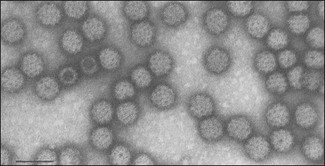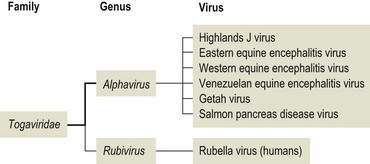Chapter 59 The family name is taken from the Latin word toga meaning cloak or mantle and is a reference to the viral envelope. Members of the family are 60–70 nm in diameter. The envelope contains glycoprotein spikes and is tightly adherent around an icosahedral capsid (Fig. 59.1). The family is composed of two genera: Alphavirus and Rubivirus (Fig. 59.2). The genus Alphavirus contains more than 25 species of which a number are important veterinary pathogens. Alphaviruses are thought to have arisen from an insect-borne plant virus, probably in the New World. They can be divided into several groupings or complexes on the basis of antigenic and genetic studies; Venezuelan equine encephalitis complex, Eastern equine encephalitis complex, Semliki Forest complex and Western equine encephalitis/Sindbis complex (Powers et al. 2001). Western equine encephalitis virus is believed to have arisen by recombination between Eastern equine encephalitis and Sindbis-like viruses (Strauss & Strauss 1994, Weaver et al. 1997). Relatively recent discoveries include an alphavirus of salmonids, the cause of salmon pancreas disease and sleeping disease of rainbow trout, as well as southern elephant seal virus. These alphaviruses are unusual in that they do not seem to require an invertebrate vector. Rubella virus, which causes German measles in humans, does not require a vector and is the sole member of the genus Rubivirus. Figure 59.1 Electron micrograph of negatively stained particles of Eastern equine encephalitis virus. The bar represents 100 nm. Reprinted with permission: Veterinary Virology Third Edition (1999). Murphy et al., Academic Press. Page 548. A number of important equine diseases are associated with infections by members of the genus Alphavirus (Table 59.1). The three equine encephalitis viruses (Venezuelan, Eastern and Western) are confined to the western hemisphere and are transmitted by mosquitoes. Getah virus is confined to southeast Asia and Australia. A number of outbreaks of disease have occurred in Japan. Table 59.1 Togaviruses of veterinary significance
Togaviridae

Virus
Arthropod vector
Significance of infection
Venezuelan equine encephalitis virus
Mosquito
Present in Central and South America with occasional outbreaks in southern USA. Causes disease in horses, donkeys and man
Eastern equine encephalitis virus
Mosquito
Present in eastern USA, Caribbean and South America. Causes disease in pheasants, horses and man
Western equine encephalitis virus
Mosquito
Present throughout much of the Americas. Causes disease in horses and man. Milder disease than EEEV
Getah virus
Mosquito
Sporadic cause of disease in horses; fever, urticaria and hind-limb oedema. Infection common in pigs but significance unclear. Present in Australia and southeast Asia
Togaviridae
Only gold members can continue reading. Log In or Register to continue

Full access? Get Clinical Tree



